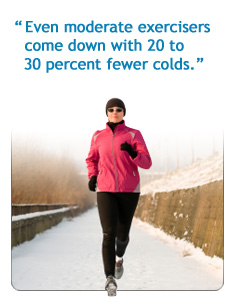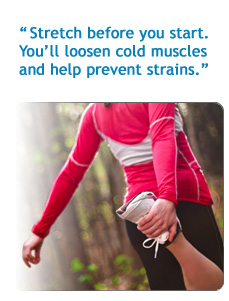 Americans love winter sports. However for too many of us, that involves watching skiing, ice hockey, and snowboarding on TV while munching on snacks. Temperatures plummet outside so we stay inside and hibernate.
Sure, some people pound out miles on a home treadmill or drive to the gym for regular workouts. However, the truth is few of us bother. According to the American Fitness Professionals and Associates (AFPA), a group that certifies personal trainers, a survey of 5,000 people found that 30 percent of Americans get no exercise at all during the winter months.
But here’s good news: with some motivation, appropriate dress and common sense safety precautions, you can actually enjoy exercising outside, even when it’s cold. The advantages? Running, walking, and other exercise outside can help beat the winter blues, increase energy, and even boost your immune system. In fact, researchers have found that even moderate exercisers come down with 20 to 30 percent fewer colds than couch potatoes –- and that’s nothing to sneeze at!
 Getting off to a healthy startYou’ve heard this advice countless times and here it comes again: always talk to your doctor before starting any new exercise program, including working out in the cold for the first time. "This allows your physician to work with you and guide you based on your own specific health status. However generally cold weather should not be a deterrent to being physically active," Bonni Messner, Staff Athletic Trainer and Strength and Conditioning Specialist in the Medical College of Georgia’s (MCG) Health Sports Medicine Department tells Synergy.
There are some people who need to be extra cautious when exercising in cold temperatures, she adds. For example, adults over 60 have a lower tolerance to cold as a result of their reduced ability to conserve heat. Anyone with coronary artery disease should be aware of symptoms of angina if they develop. Sometimes, exercising in cold weather can trigger asthma or exercise induced bronchospasm (EIB), too, no matter what your age.
"EIB is characterized by a narrowing of respiratory tract airways and it can be exacerbated by cold, dry air. While individuals who suffer from asthma are more likely to experience EIB, anyone can experience this condition," Messner explains. She adds that people at risk for EIB can use a scarf or a mask over their mouth and nose to help warm the air they breathe while exercising.
Dressing for winter exercise successPeople obviously need to dress appropriately for outdoor exercise in cold weather. However that doesn’t mean going overboard on thermal clothes and too many sweaters.
"Overdressing can cause problems if it prevents your body from dissipating excessive heat. Layering should be used for exercise in cold weather to allow for adjustment based on weather conditions and intensity of activity," Messner explains.
She advises building an exercise outfit of three layers:
- The inner layer in contact with the skin should be some type of moisture wicking material such as polypropylene. Cotton and other materials that absorb moisture should be avoided.
- The second layer should be an insulation layer such as a polyester fleece. This will help to maintain warmth while allowing moisture to escape to the outer layer.
- The outer layer should shield you from rain and wind, but still allow for moisture from sweat to evaporate. Usually the outer layer is worn only at rest or in weather conditions, such as rain or wind, since sweat rates during exercise often quickly exceed the outer layer’s ability to dissipate the vapor caused by perspiration.
Protecting your extremities from the elements is also important. James B. McGuire, D.P.M., assistant professor of podiatric medicine at Temple University, advises wearing socks made from acrylic because they keep feet dry by slicking away perspiration from inside shoes and boots.
"Athletic shoes can be up to a size larger to allow for thicker or layering of socks to prevent exposure to cold. A thin pair of gloves under a thicker pair of gloves or mittens can protect the fingers and prevent frost nip or frostbite," Messner tells Synergy. "In addition, covering the head for cold weather exercise is a vital factor that many people forget. Up to 50 percent of an individual’s body heat can be lost through exposure of the head to cold conditions."
 Warm up for your cold weather workoutDo you need to prepare differently for aerobic exercise such as jogging in cold temperatures than in warm ones? The main thing to remember, says exercise expert Messner, is to give yourself ample time to stretch before you start. You’ll loosen cold, tight muscles, and help prevent strains.
"Warm-ups should consist of an activity using similar muscle groups to the activity that you will use throughout the exercise activity you have planned. For example 10 minutes of easy to moderate paced walking is a good warm-up for running," she notes. "The warm-up should be followed by sufficient stretching targeting the major muscle groups in both the upper and lower body. Specific stretches can be added for smaller muscle groups depending on the activity and the individual’s specific needs. You may also try warming up indoors if it is just too cold to achieve an ample warm-up outside."
One difference in working out in cold weather rather than in steamy temperatures is you may assume you won’t get as thirsty. That can be a dangerous assumption, so drink up before you go out and bring that water bottle along. "It’s possible to become dehydrated in cold weather, especially if you are exercising in heavy, impermeable clothing. Also if skin temperature falls significantly, it becomes harder to recognize thirst in cold weather," Messner advises. "Maintaining adequate hydration will not only help to keep you safe while you exercise but will also help you perform your best."
Bottom line: GET MOVING!So now you know how to dress, warm up, and stay as safe as possible while working out in the great (if bone-chilling) outdoors, what is going to actually get you up off the couch and out the door?
Tips on getting, and staying motivated, to exercise in cold weather:
- Remember you’ll burn off calories from holiday splurges.
- You’ll be far happier when swimsuit season rolls around if you’ve worked on your fitness during the winter.
- Regular exercise is one of the best things you can do to protect and improve your health; you’ll decrease stress levels and sleep better, too.
"Staying motivated to get the recommended 30 minutes of moderate exercise 3 to 5 days per week can be difficult, especially when it is cold and days are shorter leaving less daylight. However if you find staying motivated difficult, try making exercise a social occasion. Work out with a friend and mix up your routine," Bonni Messner emphasizes. "Try different forms of exercise to keep it fresh and fun, too!"
|